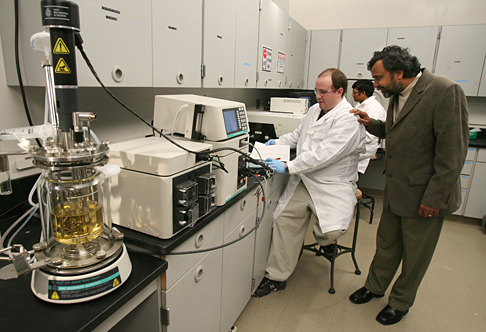In 2006, Praveen Paripati started collaboration with researchers at The University of Toledo who were investigating a unique pretreatment to help convert the sugars in cellulosic biomass — forest residues, switchgrass, corn stalks, etc. — into ethanol.

UT engineering graduate and MBA student Marcus Stacy, an intern at SuGanit Systems Inc., seated, studied lab results with SuGanit President Praveen Paripati as Dr. Ananthram Dadi, UT graduate and SuGanit employee, worked in the background.
Last month, the Ohio Third Frontier granted UT and Paripati’s Reston, Va.-based SuGanit Systems Inc. $2 million to implement the process using inputs of one ton of biomass waste.
“The grant will enable us to scale up the process and operate a pilot facility while we plan for a larger production line,” said Paripati, whose labs with UT researchers soon will be occupying space in the University’s new Nitschke Technology Commercialization Complex. His production line also will be built in Toledo.
Working with researchers in UT’s colleges of Engineering and Natural Sciences and Mathematics, the seven-person company hopes to nearly double the number of its workers over the next year as its new process creates between 60 to 90 gallons of ethanol per ton of biomass.
“The goal is to get to a point where we’re processing 40 to 50 tons of biomass per day,” Paripati said, highlighting that he chose Toledo despite his Virginia home address due to regional logistic assistance and the efforts of economic development partners in northwest Ohio.
“This is what successful economic development looks like,” said Megan Reichert, director of UT incubation. “Whether the Port Authority or the city or the Regional Growth Partnership, each partner offers something different to help entrepreneurs and small business succeed.”
SuGanit and UT researchers Dr. Sasidhar Varanasi and Dr. Patricia Relue have developed a catalyst that enables yeast to convert glucose and xylose into ethanol.
Reichert said northwest Ohio’s agricultural infrastructure offers, literally, tons of biomass, which would otherwise be thrown away or left to rot, that can be converted.
“Not only will this result in growth for SuGanit, but also the opportunity for jobs across the supply chain,” she said.
Even better, according to Paripati, is that the process leaves no waste. Lactic acid, another product of the process, can be used to create plastics and environmentally friendly cleaning solvents, he said. The rest of the material not converted to ethanol can be changed to other products.
“The flexibility of our process allows us not to depend on a single type of biomass, which means we’re impacted less by the seasonal variations of when particular types of biomass waste are available,” Paripati said.
Since 2006, Reichert and Paripati said UT and SuGanit have received more than $4 million in state and federal grants to support biofuel research activities.